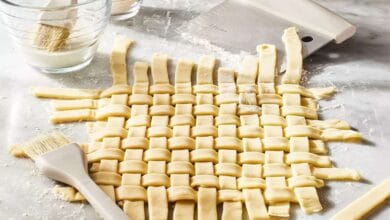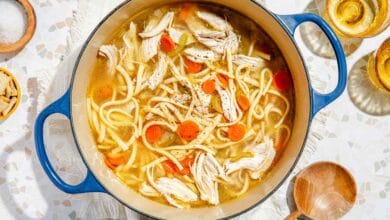The best aged Albariño you can buy now

Bright, crisp white wines from around the world, such as Sauvignon Blanc, Riesling, and Albariño, are usually best unadorned. There’s no oak influence, and nothing gets in the way of its fresh, bright charm. Still, many of the best Albariños from Spain’s coastal Rías Baixas region are aged on the lees before bottling. This technique is more common for rich Burgundy whites and California Chardonnays than for zesty coastal whites.
In winemaking, lees are the spent yeast from fermentation. As the yeast converts the sugar in the grape juice into alcohol, it dies and settles to the bottom of the fermentation vessel, whether it’s an oak barrel or a stainless steel tank.
Classically, for varieties like Albariño, winemakers would rack off the wine (that is, transfer it from one container to another, leaving the lees behind) and then age it until it was ready to be bottled. But leaving the wine in contact with the lees works its magic. It adds roundness and texture to the mouthfeel, protects the wine from future oxidation, and can give its flavors a unique savory edge. Think fresh bread, nuts, and some sort of overall umami depth.
In regions like Burgundy, lees aging (or storing the wine sur-lie, if you prefer the French style) is usually done in oak barrels. However, in Rias Baixas this stage of winemaking is usually carried out in neutral tanks. Most often stainless steel, but also granite or neutral woods such as large, old chestnut barrels.
In a sense, when winemakers choose to work this way, they get the best of both worlds in their wines. Albariño says it retains its native grapefruit-pineapple brightness and salty minerality, but adds a surprising layer of complexity. Here are nine great bottles to check out.
2024 Paso das Bursas Albariño, Rías Baixas ($25)
Paso das Bursas is an entry-level wine from the Torres family project in Rías Baixas, a grapefruit and melon Albariño blended with fruit from O Rosal and Val de Salnes. It has a tart and refreshing taste, making it ideal for all types of raw seafood. For more depth and complexity, look for the pricier Paso Torre Panelas Blanco Granito Albariño ($60). It’s grown in a single vineyard in Val de Salnes and fermented in granite eggs (and aged for eight months on the lees).
2024 Quinta de Cucero Rosal ($25)
A touch of Loureiro and Cainho Blanco gives this white from the O Rosal region of Rías Baixas a light herbal/floral aroma, while six months on fine lees gives it presence on the palate. In other words, it’s refreshing and lively, but also has a certain richness to it.
2024 Grand Bazin Amber Albariño Label ($27)
Etiqueta Ambar in Grand Bazan sources its grapes primarily from vineyards over 40 years old in Cambados and Meandro in the Salnes Valley. The juice undergoes several hours of skin contact before fermentation and is then aged on the lees in stainless steel tanks for eight months to produce an elegant white wine with lemon blossom aromas.
2022 Filaboa Selection Finca Monte Alto Albariño ($35)
A single small vineyard in the Filaboa Estate on the Minho River is the source of this always impressive Albariño. Aromas of ripe citrus and melon melt in the mouth, accompanied by the tangy acidity of the citrus peel. Finca Monte Alto is also a wine that will grow great for several years in your wine fridge if you keep a few bottles.
NV Paco & Grandfather’ Road Sparkling Albaleo ($42)
A full two years of aging on the lees in bottle gives this striking sparkling Albariño a deep yeasty/baked bread aroma that lends to fresh grapefruit aromas. Anyone looking for a cool Champagne alternative (or Prosecco alternative, or any other kind of sparkling wine alternative) should check this out.
2023 Nanclares y Prieto “O Bocoy Bella de Silvia” Rias Baixas Albariño ($45)
Alberto Nanclares and Silvia Prieto take a hands-off approach to winemaking (natural yeasts, minimal sulfur use and no additives of any kind) for all Albariño varieties, which are made from organically grown plots of older vines. This lightly oxidized, flavorful white wine is fermented in 90-year-old chestnut barrels and then rests on the lees for nine months.
2022 Attis Ambassador Albariño ($53)
A single 60-year-old vineyard in the Val de Salnes region sources this powerful, full-bodied Albariño grape, whose richness is enhanced by sparkling acidity. It is aged on the lees for two years, first in granite tanks and then in stainless steel tanks. This is the main course Albariño. Or serve with a platter of classic smoked paprika flavored pulpo a la galega..
2021 Paso Barrantes Gran Vino Albariño ($55)
While most Albariños are brought to market as quickly as possible, Paso Barrantes prefers to slow down their wines so that they can spend time developing complexity in the winery’s cellars before being released. This vintage has a beautiful aroma of savory herbs, with round tangerine and grapefruit flavors and a light nuttiness from the aged lees. Most of the wine is made in stainless steel tanks, but 15% is aged in acacia barrels.
2015 Paso de Senorans Albariño Vintage Selection ($89)
The grapes of Paso de Senorans’ top wine, Seleccion de Anada, are grown in shallow soil on what is effectively a solid bed of granite in a small old vine plot directly behind the winery. The wine is stored on its lees in stainless steel tanks for a full two and a half years before being bottled.
“When we started making Seleccion Anada in 1995, people thought it was strange,” says winemaker Ana Quintela Suárez. “All white wines were supposed to be young. What I like to remember is the ancient Albariño style, when wine was stored in large wooden tanks. It’s a rounder, richer style, perhaps not as fresh fruit, but more elegant.”
That’s certainly true of this vintage, and while this wine isn’t cheap, it’s one of Spain’s great white wines and one not to be missed.
2025-10-29 17:00:00




